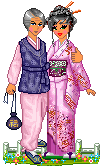Introduction: Japanese Language
Japanese Language (Nihongo) is a language spoken by over 130 million people, in Japan and Japanese emigrant communities around the world. It is an agglutinative language and is distinguished by a complex system of honorifics reflecting the hierarchical nature of Japanese society, with verb forms and particular vocabulary to indicate the relative status of speaker, listener and the person mentioned in conversation. The sound inventory of Japanese is relatively small, and has a lexically distinct pitch-accent system. Early Japanese is known largely on the basis of its state in the 8th century, when the three major works of Old Japanese were compiled; but smaller amounts of material, primarily in scriptional, are older. The earliest attestation of Japanese is in a Chinese document from 252 A.D.
The Japanese language is written with a combination of three different types of scripts: Chinese characters, kanji, and two syllabic scripts, hiragana and katakana. The Latin alphabet, rōmaji, is also often used in modern Japanese, especially for company names and logos, advertising, and when inputting Japanese into a computer. Western style Arabic numerals are generally used for numbers, but traditional Sino-Japanese numerals are also commonplace.
Japanese vocabulary has been heavily influenced by loans from other languages. A vast number of words were borrowed from Chinese, or created from Chinese models, over a period of at least 1,500 years. Since the late 19th century, Japanese has borrowed a considerable number of words from Indo-European languages, primarily English. Because of the special trade relationship between Japan and Holland in the 17th century, Dutch has also been influential, with words like bīru (from bier; "beer") and kōhī (from koffie; "coffee").


